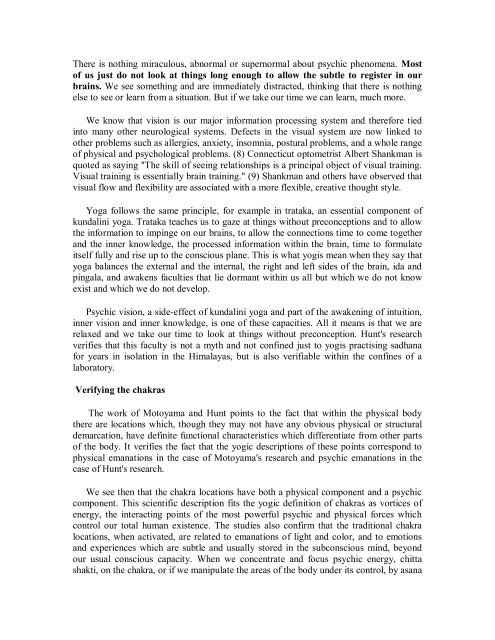Kundalini.Tantra.by.Satyananda.Saraswati
Create successful ePaper yourself
Turn your PDF publications into a flip-book with our unique Google optimized e-Paper software.
There is nothing miraculous, abnormal or supernormal about psychic phenomena. Most<br />
of us just do not look at things long enough to allow the subtle to register in our<br />
brains. We see something and are immediately distracted, thinking that there is nothing<br />
else to see or learn from a situation. But if we take our time we can learn, much more.<br />
We know that vision is our major information processing system and therefore tied<br />
into many other neurological systems. Defects in the visual system are now linked to<br />
other problems such as allergies, anxiety, insomnia, postural problems, and a whole range<br />
of physical and psychological problems. (8) Connecticut optometrist Albert Shankman is<br />
quoted as saying "The skill of seeing relationships is a principal object of visual training.<br />
Visual training is essentially brain training." (9) Shankman and others have observed that<br />
visual flow and flexibility are associated with a more flexible, creative thought style.<br />
Yoga follows the same principle, for example in trataka, an essential component of<br />
kundalini yoga. Trataka teaches us to gaze at things without preconceptions and to allow<br />
the information to impinge on our brains, to allow the connections time to come together<br />
and the inner knowledge, the processed information within the brain, time to formulate<br />
itself fully and rise up to the conscious plane. This is what yogis mean when they say that<br />
yoga balances the external and the internal, the right and left sides of the brain, ida and<br />
pingala, and awakens faculties that lie dormant within us all but which we do not know<br />
exist and which we do not develop.<br />
Psychic vision, a side-effect of kundalini yoga and part of the awakening of intuition,<br />
inner vision and inner knowledge, is one of these capacities. All it means is that we are<br />
relaxed and we take our time to look at things without preconception. Hunt's research<br />
verifies that this faculty is not a myth and not confined just to yogis practising sadhana<br />
for years in isolation in the Himalayas, but is also verifiable within the confines of a<br />
laboratory.<br />
Verifying the chakras<br />
The work of Motoyama and Hunt points to the fact that within the physical body<br />
there are locations which, though they may not have any obvious physical or structural<br />
demarcation, have definite functional characteristics which differentiate from other parts<br />
of the body. It verifies the fact that the yogic descriptions of these points correspond to<br />
physical emanations in the case of Motoyama's research and psychic emanations in the<br />
case of Hunt's research.<br />
We see then that the chakra locations have both a physical component and a psychic<br />
component. This scientific description fits the yogic definition of chakras as vortices of<br />
energy, the interacting points of the most powerful psychic and physical forces which<br />
control our total human existence. The studies also confirm that the traditional chakra<br />
locations, when activated, are related to emanations of light and color, and to emotions<br />
and experiences which are subtle and usually stored in the subconscious mind, beyond<br />
our usual conscious capacity. When we concentrate and focus psychic energy, chitta<br />
shakti, on the chakra, or if we manipulate the areas of the body under its control, <strong>by</strong> asana














![[Lonely Planet] Sri Lanka](https://img.yumpu.com/59845622/1/169x260/lonely-planet-sri-lanka.jpg?quality=85)


